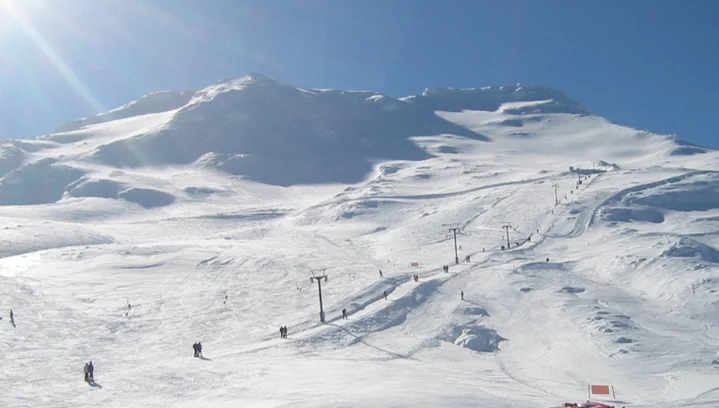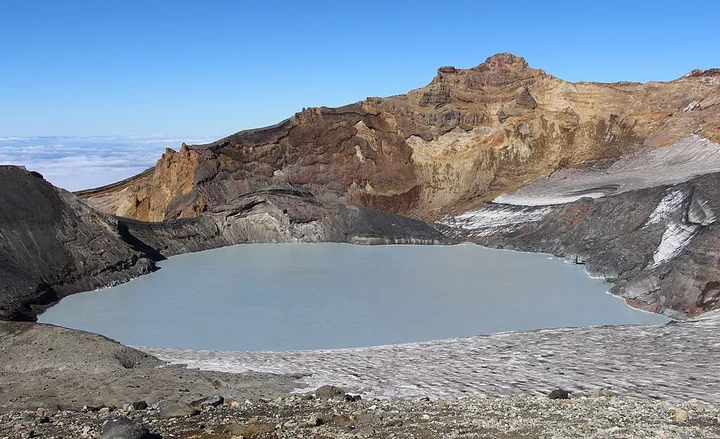Not the dumbest thing
I’ve ever done, but it’s up there. I’d picked Per up at 3.30 that
morning, and we’d driven the 30 miles south to National Park,
thence east, and south again, to the Ruapehu parking lot, which, in a
few hours, would be cram-full of skiers’ vehicles. We were early,
pre-dawn, no ski lifts for us as we slogged up, first on the packed
snow of the steep runs, then shin-deep in the virgin snow above the
top-most lift station. It took us four hours of heavy going to get to
Tahurangi, the highest of the mountain’s three summits. There we
panted, catching up on our oxygen demands, just the two of us in that
heady world, higher than anything or anyone else in New Zealand’s
North Island.
We hiked up at dawn, following the lift towers. Image: Daltonfox, CC BY-SA 3.0, via Wikimedia Commons
In our youthful ignorance and bravado, we’d both dressed badly. I wore my ancient Boy Scout anorak, no longer waterproof or even windproof, over a thin sweater suitable for New Zealand’s warm climate. Thin pants. And not much else. It was cold, man! Seemed like a hurricane was blowing up there at 9,000+ feet. But hey, no problem! A few hundred feet below us we could see steam rising off Ruapehu’s crater lake. Its warm water called out to us, and we responded by shimmying, slip-sliding-away, down a steep snow field. At the lake, we stripped and waded in, cold air giving way to warm water. It should have been bliss, except …
… have you ever swum in the crater lake of a volcano? You do know, don’t you, that what you’re smelling, that rotten egg smell, is hydrogen sulfide? And that what you’re swimming in is basically sulfuric acid, aka battery acid? We sure knew it soon enough. With a pH value of around 1 (drinking water from your tap is near-neutral, neither acid nor alkali, pH 7), Ruapehu’s crater lake is lethal. Or would have been if we hadn’t gotten out, fast, feeling like a thousand knives were attacking our skin. Nearly 60 years later, I still shudder.
Crater Lake and Tahurangi, the highest peak. When we summited, it was all snow-covered. Image: Michal Klajban, CC BY-SA 4.0, via Wikimedia Commons
That lake is notorious
for other things than trying to turn regular humans into
flesh-drooping zombies. Late on the evening of Christmas Eve, 1953,
the tephra dam holding the lake within the crater broke, sending a
mudflow (lahar) racing down the slopes into the Whangaehu River
below, destroying the Tangiwai railway bridge minutes before an
express passenger train would have crossed it. The locomotive and six
carriages plunged into the river, killing 151 people in New Zealand’s
worst rail accident.
Auckland Star, December 26, 1953. Image: Archives New Zealand from New Zealand, CC BY-SA 2.0, via Wikimedia Commons
Twelve years after the tragedy, those two young men — kids, really — got the hell away from the lake, skin smarting — oh, did it smart!—chastened by their dumb exploit. We hustled down the mountain as fast as we could, back to my car, and drove back to Taumarunui. Neither of us never really felt right again until we’d taken long showers to get the remnants of acid off our skin. Like I say, I can still re-experience what it felt like many, many years later.
Pardon the pun, but I like to think I’m smarter now.



CLICK TO MANAGE